#2I/Borisov
Explore tagged Tumblr posts
Text
Astronomy Highlights, 2019
In 2019, the field of astronomy was filled with groundbreaking discoveries that captivated the world’s attention. Here are ten of the most widely covered astronomical discoveries of the year: First-ever image of a black hole – In April 2019, astronomers released the first-ever image of a black hole located in the galaxy Messier 87. The image was captured by the Event Horizon Telescope, an…
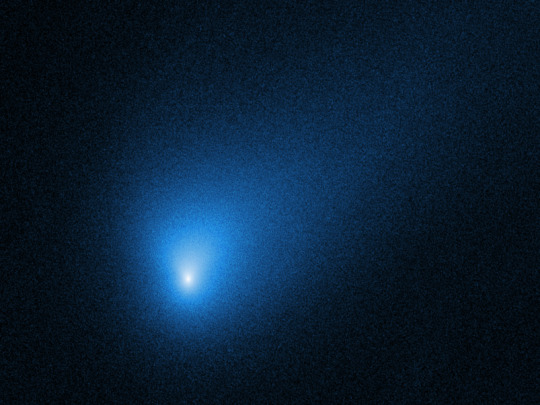
View On WordPress
#2I/Borisov#astronomy#black holes#comets#dark matter#exoplanets#fast radio burst#K2-18b#Kepler-47 system#Messier 87#neutron stars#Planet Nine#universe#white dwarf star
4 notes
·
View notes
Text
5 Unpredictable Things Swift Has Studied (and 1 It’s Still Looking For)
Our Neil Gehrels Swift Observatory — Swift for short — is celebrating its 20th anniversary! The satellite studies cosmic objects and events using visible, ultraviolet, X-ray, and gamma-ray light. Swift plays a key role in our efforts to observe our ever-changing universe. Here are a few cosmic surprises Swift has caught over the years — plus one scientists hope to see.

#BOAT
Swift was designed to detect and study gamma-ray bursts, the most powerful explosions in the universe. These bursts occur all over the sky without warning, with about one a day detected on average. They also usually last less than a minute – sometimes less than a few seconds – so you need a telescope like Swift that can quickly spot and precisely locate these new events.
In the fall of 2022, for example, Swift helped study a gamma-ray burst nicknamed the BOAT, or brightest of all time. The image above depicts X-rays Swift detected for 12 days after the initial flash. Dust in our galaxy scattered the X-ray light back to us, creating an extraordinary set of expanding rings.

Star meets black hole
Tidal disruptions happen when an unlucky star strays too close to a black hole. Gravitational forces break the star apart into a stream of gas, as seen above. Some of the gas escapes, but some swings back around the black hole and creates a disk of debris that orbits around it.
These events are rare. They only occur once every 10,000 to 100,000 years in a galaxy the size of our Milky Way. Astronomers can’t predict when or where they’ll pop up, but Swift’s quick reflexes have helped it observe several tidal disruption events in other galaxies over its 20-year career.

Active galaxies
Usually, we think of galaxies – and most other things in the universe – as changing so slowly that we can’t see the changes. But about 10% of the universe’s galaxies are active, which means their black hole-powered centers are very bright and have a lot going on. They can produce high-speed particle jets or flares of light. Sometimes scientists can catch and watch these real-time changes.
For example, for several years starting in 2018, Swift and other telescopes observed changes in a galaxy’s X-ray and ultraviolet light that led them to think the galaxy’s magnetic field had flipped 180 degrees.

Magnetic star remnants
Magnetars are a type of neutron star, a very dense leftover of a massive star that exploded in a supernova. Magnetars have the strongest magnetic fields we know of — up to 10 trillion times more intense than a refrigerator magnet and a thousand times stronger than a typical neutron star’s.
Occasionally, magnetars experience outbursts related to sudden changes in their magnetic fields that can last for months or even years. Swift detected such an outburst from a magnetar in 2020. The satellite’s X-ray observations helped scientists determine that the city-sized object was rotating once every 10.4 seconds.

Comets
Swift has also studied comets in our own solar system. Comets are town-sized snowballs of frozen gases, rock, and dust. When one gets close to our Sun, it heats up and spews dust and gases into a giant glowing halo.
In 2019, Swift watched a comet called 2I/Borisov. Using ultraviolet light, scientists calculated that Borisov lost enough water to fill 92 Olympic-size swimming pools! (Another interesting fact about Borisov: Astronomers think it came from outside our solar system.)

What's next for Swift?
Swift has studied a lot of cool events and objects over its two decades, but there are still a few events scientists are hoping it’ll see.
Swift is an important part of a new era of astrophysics called multimessenger astronomy, which is where scientists use light, particles, and space-time ripples called gravitational waves to study different aspects of cosmic events.

In 2017, Swift and other observatories detected light and gravitational waves from the same event, a gamma-ray burst, for the first time. But what astronomers really want is to detect all three messengers from the same event.
As Swift enters its 20th year, it’ll keep watching the ever-changing sky.
Keep up with Swift through NASA Universe on X, Facebook, and Instagram. And make sure to follow us on Tumblr for your regular dose of space!
2K notes
·
View notes
Text
Otra nave vigía podría ser enviada por extraterrestres para investigarnos como Oumuamua
Veamos
Finalmente tenemos los medios tecnológicos para detectar objetos interestelares. Hemos detectado dos en los últimos años, ‘Oumuamua y 2I/Borisov, y sin duda hay más por ahí. Como tal, ha habido mucho interés en desarrollar una misión que pueda visitar uno una vez que lo detectemos. Pero, ¿cómo sería una misión así? Ahora, un borrador de un documento de un equipo de científicos principalmente…

View On WordPress
3 notes
·
View notes
Link
Astronomers have discovered two known interstellar objects (ISO), ‘Oumuamua and 21/Borisov. But there could be thousands of these objects passing through the Solar System at any time. According to a new paper, the upcoming Vera Rubin Telescope will be a fantastic interstellar object hunter, and could possibly find up to 70 objects a year coming from other star systems. The Rubin Observatory is a ground-based telescope located high in the Chilean Andes. It is expected to see first light sometime in 2025, a timeline that has already been pushed back a few times. The observatory’s 8.4-meter Simonyi Survey Telescope will take images of the sky using the highest resolution digital camera in the world, a 3,200-megapixel camera that includes the world’s largest fish-eye lens. The camera is roughly the size of a small car and weighs almost 2800 kg (6200 lbs). This survey telescope is fast-moving and will be able to scan the entire visible sky in the southern hemisphere every few nights. One of the main projects for Rubin Observatory is the Legacy Survey of Space and Time (LSST), expected to last at least 10 years. Researchers anticipate this project will gather data on more than 5 million asteroid belt objects, 300,000 Jupiter Trojans, 100,000 near-Earth objects, and more than 40,000 Kuiper belt objects. Since Rubin will be able to map the visible night sky every few days, many of these objects will be observed hundreds of times. Because of the telescope’s repeated observations, there will be an enormous amount of data to calculate the positions and orbits of all these objects. With all that data and mapping, it is expected that Rubin will be able to detect faint interstellar objects – and these speedy ISOs might even actually stand out among all the other objects. Basically, the LSST will be able to capture a timelapse view of interstellar objects on their fast journeys through our Solar System. ‘Oumuamua (l) and 2I/Borisov (r) are the only two ISOs we know of for certain. Image Credit: Left: By Original: ESO/M. Kornmesser; right, Hubble Space Telescope/NASA/ESA. Various estimates and predictions have been coming from various astronomers about how many interstellar objects Rubin will be able to detect. One estimate said five a year, another 7, another 21. A new pre-print paper published on arXiv suggested that LSST could find up to 70 interstellar objects every year. “The annual rate at which LSST should discover ’Oumuamua-like interstellar objects ranges from about 0?70 detected objects per year,” write astronomers Dusan Marceta and Darryl Z. Seligman. To come up with this number, they applied recently developed tool called the Object In Field (OIF) algorithm. A rendering of the LSST Camera with a cut away to show the inner workings. Credit: LSST. “It serves as an observation generator that simulates a real LSST campaign,” Marceta told Universe Today via email, “providing time and coordinates for every LSST field of view (FOV) and exposure time. It also allows for the inclusion of an arbitrary population of moving solar system objects, such as asteroids or comets. It then propagates their motion, determines their positions in the sky, and detects whether some of them appear in the mentioned FOVs.” Marceta, a professor at the University of Belgrade said that they developed a method to generate a population of interstellar asteroids and utilized the OIF to assess how many of these objects can be detected by LSST under various conditions. “Given the unconstrained nature of the interstellar objects’ population, we considered a wide range of possibilities for critical parameters,” he said. “This encompassed size distributions, the range of albedo, and their assumed motions in interstellar space. Taking all these factors into account, we arrived at a range of 0-70 objects per year.” This assumes that at least that many interstellar objects actually exist. Marceta said they assumed a number density of 0.1 object per cubic astronomical unit, a value implied by the detection of ‘Oumuamua, “which remains highly uncertain, similar to other parameters associated with this population,” he said. However, because ISOs move so fast, they might be easier to detect with the Rubin Observatory because of an effect called ‘trailing loss.’ “It’s an effect that occurs when a rapidly moving object is within the telescope’s FOV,” Marceta explained. “To excite a pixel on the CCD, a certain number of photons must land on it during the exposure time (which is 15 seconds in our simulations). For stationary objects like stars, all photons during the exposure time hit the same area of the CCD. However, for an object that changes its position during the exposure time, the photons land on different pixels as it moves.” The complete focal plane of the future LSST Camera is more than 2 feet wide and contains 189 individual sensors that will produce 3,200-megapixel images. Crews at SLAC have now taken the first images with it. (Jacqueline Orrell/SLAC National Accelerator Laboratory) Marceta said that even if the total number of photons may be sufficient to excite a pixel, if they are spread across a large number of pixels, it’s possible that none of the pixels receive enough photons to exceed the background noise. “The faster the object moves, the greater the number of pixels that receive the photons, making trailing loss more noticeable,” he said. “Our simulation shows that interstellar objects can appear in the telescope’s field of view with velocities significantly exceeding those of the fastest solar system populations, which makes this issue particularly important.” But of course, this is a chicken-and-the-egg type conundrum. Because of a sample size of only two, scientists can now only make loose predictions of how many interstellar objects Rubin will reveal. Once a larger sample of interstellar objects are able to be counted and analyzed, astronomers will have a much better idea of the population of these objects … which will likely only happen after the Rubin Observatory is up and running. But Marceta and Seligman are hopeful that Rubin and the LSST will change everything. “It is possible that the number density of ‘Oumuamua-like objects is higher than currently estimated due to a large fraction of interstellar objects currently undetectable due to trailing loss and rapid sky motions,” they write. The more we can find, the better, because some of these will be in the perfect trajectory for an interstellar interceptor mission. Learning details about objects from other solar systems could fundamentally change our view of the universe and our place in it. The post Vera Rubin Observatory Could Find Up to 70 Interstellar Objects a Year appeared first on Universe Today.
0 notes
Photo
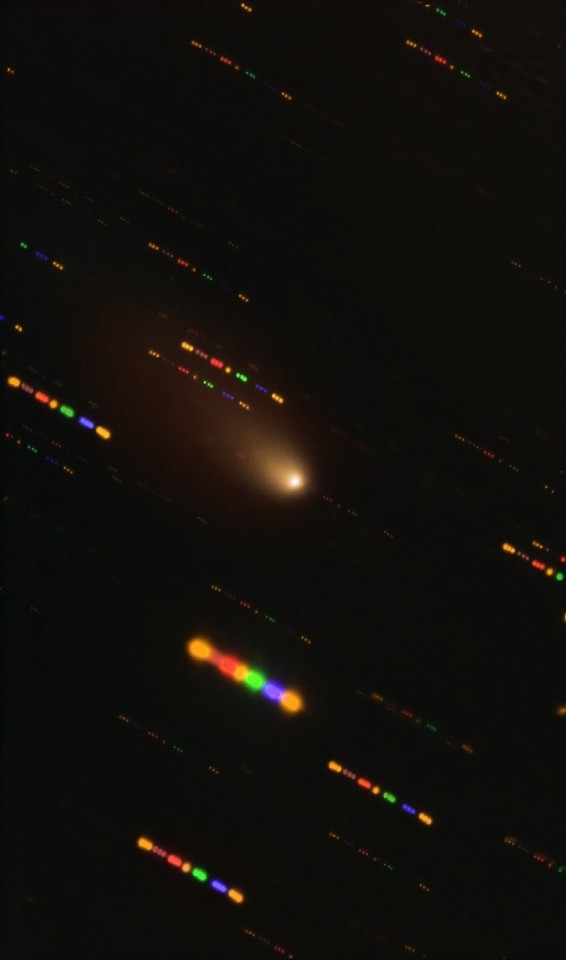
Interstellar Comet and Disco Stars
104 notes
·
View notes
Text
First identified comet to visit our solar system from another star
When astronomers see something in the universe that at first glance seems like one-of-a-kind, it's bound to stir up a lot of excitement and attention. Enter comet 2I/Borisov. This mysterious visitor from the depths of space is the first identified comet to arrive here from another star. We don't know from where or when the comet started heading toward our Sun, but it won't hang around for long. The Sun's gravity is slightly deflecting its trajectory, but can't capture it because of the shape of its orbit and high velocity of about 100,000 miles per hour.
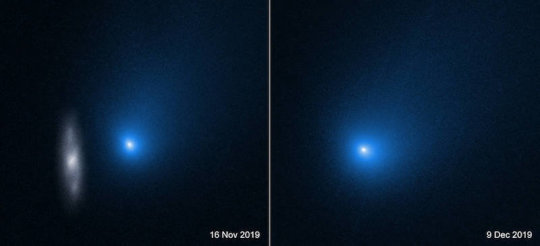
Telescopes around the world have been watching the fleeting visitor. NASA's Hubble Space Telescope has provided the sharpest views as the comet skirts by our Sun. Since October the space telescope has been following the comet like a sports photographer following horses speeding around a racetrack. Hubble revealed that the heart of the comet, a loose agglomeration of ices and dust particles, is likely no more than about 3,200 feet across, about the length of nine football fields. Though comet Borisov is the first of its kind, no doubt there are many other comet vagabonds out there, plying the space between stars. Astronomers will eagerly be on the lookout for the next mysterious visitor from far beyond.
These two images, taken by Hubble, capture comet 2I/Borisov streaking through our solar system and on its way back to interstellar space. It is only the second interstellar object known to have passed through the solar system.
Nov. 16, 2019, photo
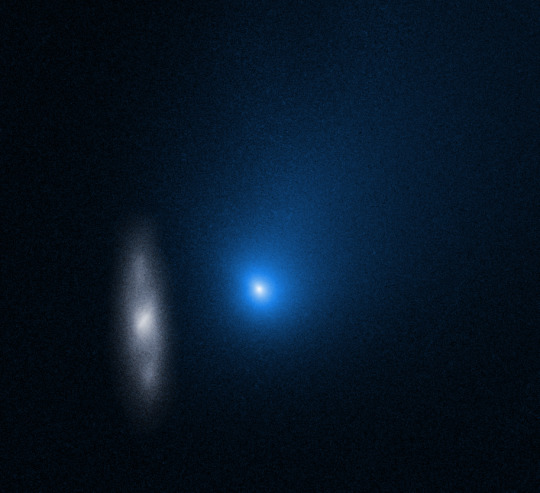
The comet appears in front of a distant background spiral galaxy (2MASX J10500165-0152029). The galaxy's bright central core is smeared in the image because Hubble was tracking the comet. Comet Borisov was approximately 203 million miles from Earth in this exposure. Its tail of ejected dust streaks off to the upper right. The comet has been artificially colored blue to discriminate fine detail in the halo of dust, or coma, surrounding the central nucleus. It also helps to visually separate the comet from the background galaxy.
Dec. 9, 2019, photo
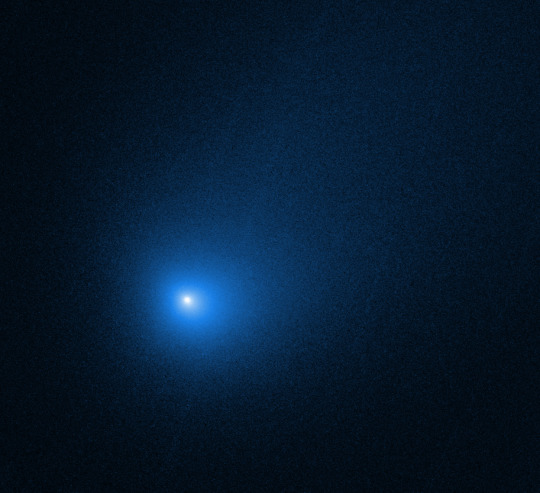
Hubble revisited the comet shortly after its closest approach to the Sun where it received maximum heating after spending most of its life in frigid interstellar space. The comet also reached a breathtaking maximum speed of about 100,000 miles per hour. Comet Borisov is 185 million miles from Earth in this photo, near the inner edge of the asteroid belt but below it. The nucleus, an agglomeration of ices and dust, is still too small to be resolved. The bright central portion is a coma made up of dust leaving the surface. The comet will make its closest approach to Earth in late December at a distance of 180 million miles.
"Hubble gives us the best upper limit of the size of comet Borisov's nucleus, which is the really important part of the comet," said David Jewitt, a UCLA professor of planetary science and astronomy, whose team has captured the best and sharpest look at this first confirmed interstellar comet. "Surprisingly, our Hubble images show that its nucleus is more than 15 times smaller than earlier investigations suggested it might be. Our Hubble images show that the radius is smaller than half a kilometer. Knowing the size is potentially useful for beginning to estimate how common such objects may be in the solar system and our galaxy. Borisov is the first known interstellar comet, and we would like to learn how many others there are."
Crimean amateur astronomer Gennady Borisov discovered the comet on Aug. 30, 2019, and reported the position measurements to the International Astronomical Union's Minor Planet Center in Cambridge, Massachusetts. The Center for Near-Earth Object Studies at NASA's Jet Propulsion Laboratory in Pasadena, California, working with the Minor Planet Center, computed an orbit for the comet, which shows that it came from elsewhere in our Milky Way galaxy, point of origin unknown.
Nevertheless, observations by numerous telescopes show that the comet's chemical composition is similar to the comets found inside our solar system, providing evidence that comets also form around other stars. By the middle of 2020 the comet will have already zoomed past Jupiter's distance of 500 million miles on its way back into the frozen abyss of interstellar space.
116 notes
·
View notes
Video
youtube
1 note
·
View note
Link
The second space rock seen visiting our solar system from another star is proving just how bizarre the first known interstellar object, ‘Oumuamua, really was.
‘Oumuamua raised eyebrows when it appeared in October 2017 looking more like a rocky asteroid than an icy comet (SN: 10/27/17). Because comets form farther from their host stars than asteroids, it should be easier for comets to escape their star’s gravity to wander the galaxy. So astronomers expect the vast majority of interstellar vagabonds to be icy bodies. But ‘Oumuamua didn’t sport the gaseous halo or tail that forms when sunlight vaporizes a comet’s ice.
Now, new telescope images confirm that a second interstellar object called 2I/Borisov (originally dubbed C/2019 Q4 (Borisov)) looks like a garden-variety comet, researchers report online October 14 in Nature Astronomy. The cometlike appearance of this object, first glimpsed August 30, suggests that ‘Oumuamua’s weirdness was a one-off, and that astronomers’ models of planetary systems are on the right track (SN: 9/12/19).
Astronomers observed 2I/Borisov on two nights in September with the William Herschel Telescope in the Spanish Canary Islands and the Gemini North Telescope in Hawaii. Those images reveal that, like comets native to our solar system, 2I/Borisov’s core is shrouded in a gaseous halo trailed by a faint, broad stream of gas and dust.
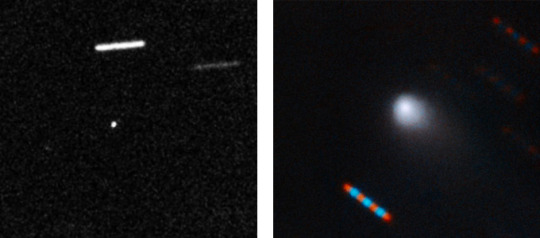
The first known interstellar object, ‘Oumuamua, appeared to be a naked space rock (left, center). But 2I/Borisov (right, center) bears the usual characteristics of a comet: It’s cloaked in a halo of vaporizing gas and trailing a gaseous tail in its wake. CREDIT: GEMINI OBSERVATORY/NSF/AURA; ALAN FITZSIMMONS/ARC/QUEEN’S UNIVERSITY BELFAST, ISAAC NEWTON GROUP, NASA
“It’s kind of relieving that finally we have something that meets our expectations,” says study coauthor Michał Drahus, an astronomer at Jagiellonian University in Kraków, Poland. “Now we really can be absolutely sure that ‘Oumuamua was one weird object.”
Whereas ‘Oumuamua vanished within weeks of its discovery, astronomers have several months to take a closer look at 2I/Borisov. Higher-resolution telescope images may tease out the exact size and shape of its core, and inspecting the specific wavelengths of light emanating from the comet could help astronomers flesh out its chemical composition.
Preliminary wavelength observations have already hinted that 2I/Borisov contains cyanogen gas (made of carbon and nitrogen atoms), which is relatively common in comets native to the solar system. Astronomer Alan Fitzsimmons of Queen’s University Belfast in Northern Ireland and colleagues report these findings October 2 at arXiv.org.
30 notes
·
View notes
Photo

Possible fragmentation of interstellar comet 2I/Borisov
Images obtained by HST/WFC3 GO programs 16041 (PI Jewitt; ATEL #13611) and 16040 (PI Bolin) on 2020 March 23 and 28 indicate the presence of a small fragment separated by ~0.3 arcsec in the anti-solar direction, west of north, from the coma's optocenter in addition to the bimodal appearance described by Jewitt et al. ATEL #13611. The distance between the optocenter and the fragment changes by 1-2 pixels (0.0395 arcsec/pixel) between the 2020 March 23 and 2020 March 28 observation dates. This implies a lower limit on the relative velocity between the nucleus and the fragment due to projection effects of at least ~0.5 m/s, consistent with the escape velocity from a sub km-scale radius body. The angular separation and motion detected in the 2020 March 23 and 28 data are consistent with a release date in 2020 March 7 around the time of the comet's ~0.7 mag outburst observed by ground-based facilities (Drahus et al. ATel #13549., Jehin et al. 2020, CBET 4729). The fragment is not seen in the most recent HST/WFC3 data taken on 2020 February 24 (GO 16041, PI Jewitt) which were acquired before the comet's outburst. The fragment has an estimated upper size limit of <100 m, assuming a geometric albedo of 0.04, and is confirmed in HST/WFC3 2020 March 30 data taken by HST GO 16087, PI Jewitt. In addition, the post-outburst HST/WFC3 images show the existence of two new jets with position angles of 240 and 310 degrees not observed in previous HST/WFC3 images (Bolin 2020, arxiv:1912.07386).
2 notes
·
View notes
Text
Astrônomos conseguem nova foto de cometa 14 vezes maior que a Terra
Astrônomos conseguem nova foto de cometa 14 vezes maior que a Terra
Os astrônomos capturaram a melhor e mais próxima imagem até agora do cometa interestelar 2I/Borisov, um visitante que se originou de fora do nosso sistema solar.

Nosso planeta (à direita), comparado com o tamanho do cometa 2I/Borisov.
Este é apenas o segundo objeto interestelar a atravessar nosso sistema solar. O primeiro foi o ‘Oumuamua em 2017.
Astrônomos da Universidade de Yale…
View On WordPress
1 note
·
View note
Text
Ze willen zoeken op de oceaanbodem naar een interstellaire meteoriet die in 2014 op aarde neerkwam
Ze willen zoeken op de oceaanbodem naar een interstellaire meteoriet die in 2014 op aarde neerkwam
Een voorbeeld van een heldere meteoor, in dit geval een Leonide. Credit: Navicore/Wikipedia. Op 8 januari 2014 was een heldere meteoor zichtbaar in Azië, die als meteoriet ergens neerplonste voor de kust van Papoea Nieuw Guinea. Zoiets komt iedere dag wel voor, zo’n meteoriet uit de ruimte die neerkomt op aarde. Maar met CNEOS 2014-01-08, zoals de meteoriet door het leven gaat, was iets anders…
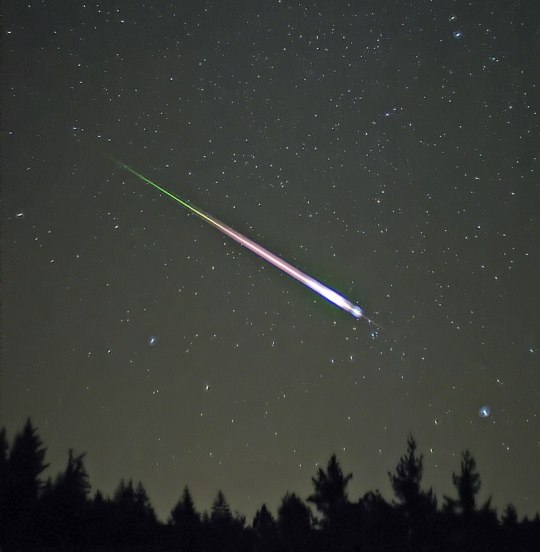
View On WordPress
0 notes
Text
Ze willen zoeken op de oceaanbodem naar een interstellaire meteoriet die in 2014 op aarde neerkwam
Ze willen zoeken op de oceaanbodem naar een interstellaire meteoriet die in 2014 op aarde neerkwam
Een voorbeeld van een heldere meteoor, in dit geval een Leonide. Credit: Navicore/Wikipedia. Op 8 januari 2014 was een heldere meteoor zichtbaar in Azië, die als meteoriet ergens neerplonste voor de kust van Papoea Nieuw Guinea. Zoiets komt iedere dag wel voor, zo’n meteoriet uit de ruimte die neerkomt op aarde. Maar met CNEOS 2014-01-08, zoals de meteoriet door het leven gaat, was iets anders…
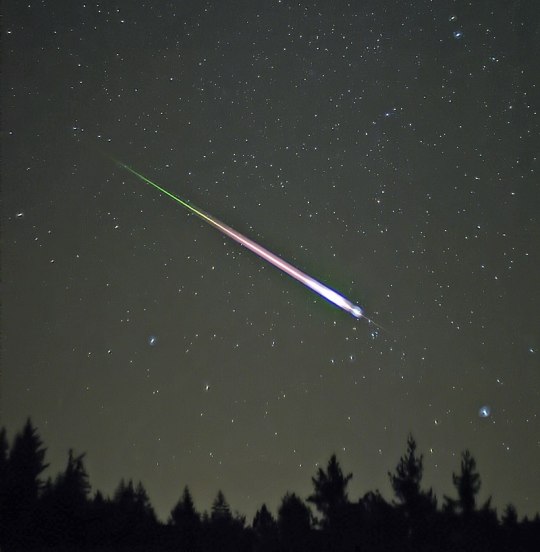
View On WordPress
0 notes
Text
¡Un nuevo estudio muestra cómo nuestro Sol podría capturar planetas rebeldes de forma permanente!
Las fuerzas gravitacionales combinadas del Sol y la Vía Láctea desempeñan un papel crucial en este proceso. El campo gravitacional de la galaxia, incluidos los efectos de la materia oscura, influyen significativamente en la forma en que se capturan los ob
El interés por los objetos interestelares (ISO) se despertó en 2017 cuando ‘Oumuamua sobrevoló nuestro Sistema Solar y sobrevoló la Tierra. Aproximadamente dos años después, otro ISO pasó por nuestro Sistema Solar: el cometa interestelar 2I/Borisov. Estos encuentros confirmaron que los ISO no solo son muy comunes, sino que pasan por nuestro Sistema Solar con regularidad, algo que los astrónomos…
0 notes
Link
Tucson AZ (SPX) Aug 11, 2023 Many as-yet-undiscovered interstellar objects exist throughout our Milky Way Galaxy: comets and asteroids that have been ejected from their home star systems. Some of these objects pass through our Solar System, bringing valuable information about how planetary systems form and evolve. Currently, only two such interstellar visitors have been discovered: 1I/?Oumuamua and comet 2I/Borisov. Rubin's
0 notes
Photo

Interstellar Object and Background Spiral
42 notes
·
View notes